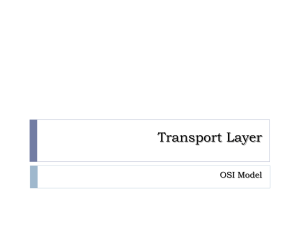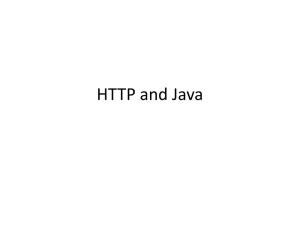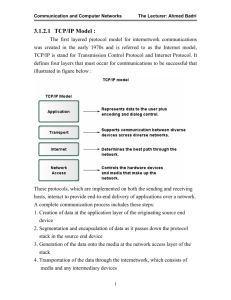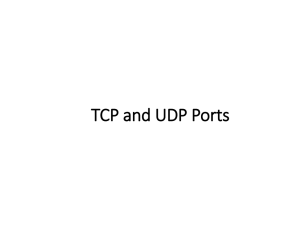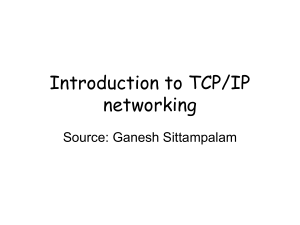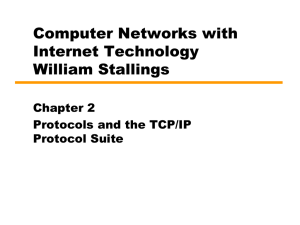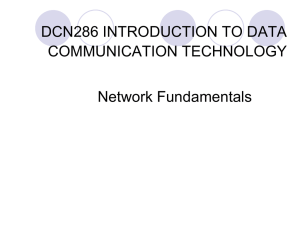Name
advertisement
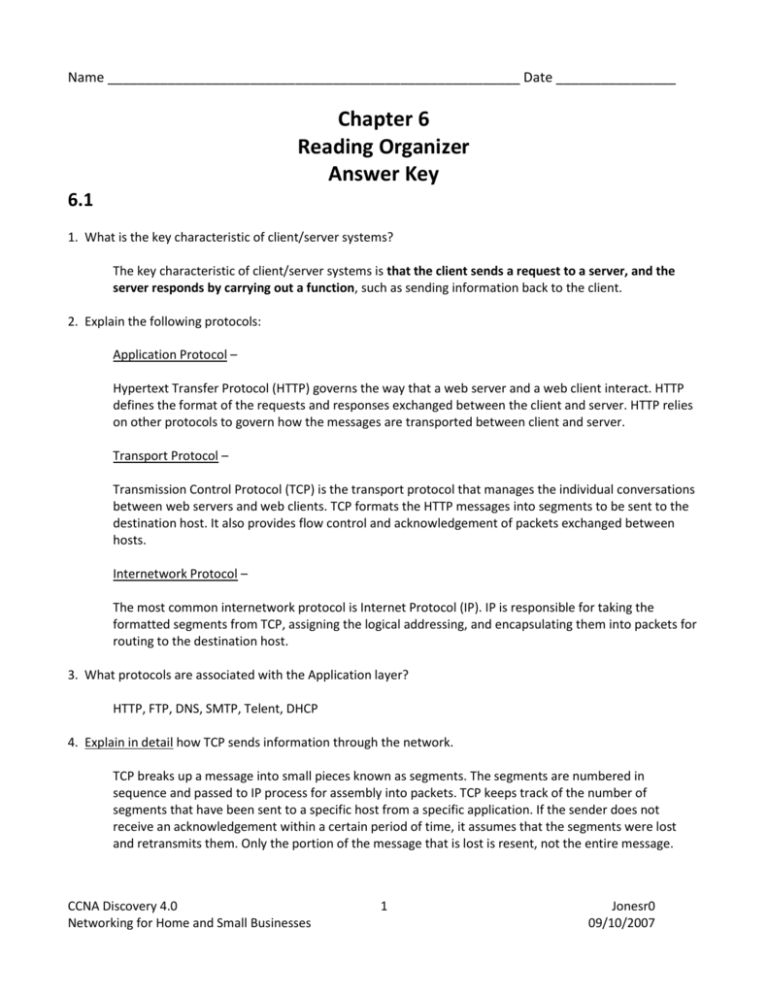
Name _______________________________________________________ Date ________________ Chapter 6 Reading Organizer Answer Key 6.1 1. What is the key characteristic of client/server systems? The key characteristic of client/server systems is that the client sends a request to a server, and the server responds by carrying out a function, such as sending information back to the client. 2. Explain the following protocols: Application Protocol – Hypertext Transfer Protocol (HTTP) governs the way that a web server and a web client interact. HTTP defines the format of the requests and responses exchanged between the client and server. HTTP relies on other protocols to govern how the messages are transported between client and server. Transport Protocol – Transmission Control Protocol (TCP) is the transport protocol that manages the individual conversations between web servers and web clients. TCP formats the HTTP messages into segments to be sent to the destination host. It also provides flow control and acknowledgement of packets exchanged between hosts. Internetwork Protocol – The most common internetwork protocol is Internet Protocol (IP). IP is responsible for taking the formatted segments from TCP, assigning the logical addressing, and encapsulating them into packets for routing to the destination host. 3. What protocols are associated with the Application layer? HTTP, FTP, DNS, SMTP, Telent, DHCP 4. Explain in detail how TCP sends information through the network. TCP breaks up a message into small pieces known as segments. The segments are numbered in sequence and passed to IP process for assembly into packets. TCP keeps track of the number of segments that have been sent to a specific host from a specific application. If the sender does not receive an acknowledgement within a certain period of time, it assumes that the segments were lost and retransmits them. Only the portion of the message that is lost is resent, not the entire message. CCNA Discovery 4.0 Networking for Home and Small Businesses 1 Jonesr0 09/10/2007 5. What are two protocols that use TCP to ensure delivery of data? FTP, and HTTP 6. Explain how UDP differs from TCP? UDP is a 'best effort' delivery system that does not require acknowledgment of receipt. This is similar to sending a standard letter through the postal system. It is not guaranteed that the letter is received, but the chances are good. 7. Why is UDP prefered with applications such as streaming audio, video and voice over IP (VoIP)? Acknowledgments would slow down delivery and retransmissions are undesirable. 8. 9. When a message is delivered using either TCP or UDP, the protocols and services requested are identified by a port number. Explain what port numbers are and how they are used. A port is a numeric identifier within each segment that is used to keep track of specific conversations and destination services requested. Every message that a host sends contains both a source and destination port. CCNA Discovery 4.0 Networking for Home and Small Businesses 2 Jonesr0 09/10/2007 6.2 10. What does the Domain Name System (DNS) provide? A way for hosts to use a name to request the IP address of a specific server. 11. Domain name servers maintain a table. What information do these tables contain? A DNS server contains a table that associates hostnames in a domain with corresponding IP addresses. Complete Lab Activity 6.2.1 12. When a web client receives the IP address of a web server what occurs? The client browser uses that IP address and port 80 to request web services. This request is sent to the server using the Hypertext Transfer Protocol (HTTP). 13. What protocol do web servers use to transfer data? HTTP Complete Packet Tracer Activity 6.2.2 14. What is the purpose of ( File Transfer Protocol FTP)? The File Transfer Protocol (FTP) provides an easy method to transfer files from one computer to another. 15. Which two port numbers are associated with FTP? 20 and 21 Complete Lab Activity 6.2.1 16. What is Simple Mail Transfer Protocol (SMTP) used for? SMTP is used by an email client to send messages to its local email server. 17. What port number is associated with SMTP? Port 25 CCNA Discovery 4.0 Networking for Home and Small Businesses 3 Jonesr0 09/10/2007 18. Explain in detail the differences between POP3 and IMAP4? Post Office Protocol (POP3) A server that supports POP clients receives and stores messages addressed to its users. When the client connects to the email server, the messages are downloaded to the client. By default, messages are not kept on the server after they have been accessed by the client. Clients contact POP3 servers on port 110. Internet Message Access Protocol (IMAP4) A server that supports IMAP client also receives and stores messages address to its users. However, it keeps the messages in the mailboxes on the server, unless they are deleted by the user. The most current version of IMAP is IMAP4 which listens for client requests on port 143. Complete Lab Activity 6.2.4 19. Explain what Instant Messaging (IM) is used for. IM software is run locally on each computer and allows users to communicate or chat over the Internet in real-time. 20. Explain in detail Voice over IP (VoIP). Making telephone calls over the Internet is becoming increasingly popular. An Internet telephony client uses peer-to-peer technology similar to that used by instant messaging. IP telephony makes use of Voice over IP (VoIP) technology which uses IP packets to carry digitized voice as data. 21. It is necessary for a server to know which services are being requested by a client (such as: DNS, Web, Email, FTP, etc). How can these client requests be identified by the server? Client requests can be identified because the request is made to a specific destination port. Clients are pre-configured to use a destination port that is registered on the Internet for each service. CCNA Discovery 4.0 Networking for Home and Small Businesses 4 Jonesr0 09/10/2007 22. Ports are broken into three categories and range in number from 1 to 65,535. Ports are assigned and managed by an organization known as the Internet Corporation for Assigned Names and Numbers (ICANN ). List and explain the three port number categories. Well-Known Ports Destination ports that are associated with common network applications are identified as well-known ports. These ports are in the range of 1 to 1023. Registered Ports Ports 1024 through 49151 can be used as either source or destination ports. These can be used by organizations to register specific applications such as IM applications. Private Ports Ports 49152 through 65535, often used as source ports. These ports can be used by any application. 6.3 23. List and explain the four layers of the TCP/IP model. 24. Of the four layers, which layer will deal with cabling issues? (Circle one) Layer 4 Layer 3 Layer 2 CCNA Discovery 4.0 Networking for Home and Small Businesses Layer1 5 Jonesr0 09/10/2007 25. What are four advantages of the layered model? a. Assists in protocol design, because protocols that operate at a specific layer have defined information that they act upon and a defined interface to the layers above and below. b. Fosters competition because products from different vendors can work together. c. Prevents technology or capability changes in one layer from affecting other layers above and below. d. Provides a common language to describe networking functions and capabilities. 26. When sending messages on a network, the protocol stack on a host operates from top to bottom. Explain in detail what happens during this process. As the web page is sent down the web server protocol stack, the application data is broken into TCP segments. Each TCP segment is given a header containing a source and destination port. The TCP segment encapsulates HTTP protocol and web page HTML user data and sends it down to the next protocol layer, which is IP. Here the TCP segment is encapsulated within an IP packet, which adds an IP header. The IP header contains source and destination IP addresses. Next, the IP packet is sent to the Ethernet protocol where it is encapsulated in a frame header and trailer. Each Ethernet frame header contains a source and destination MAC address. The trailer contains error checking information. Finally the bits are encoded onto the Ethernet media (copper or fiber optic cable) by the server NIC. 27. What information is contained in an IP header during the above process? The IP header contains source and destination IP addresses. 28. What three items are contained in an IP header and trailer during the above process? a. source MAC address b. destination MAC address c. error-checking information CCNA Discovery 4.0 Networking for Home and Small Businesses 6 Jonesr0 09/10/2007 29. When messages are received from the network, the protocol stack on a host operates from bottom to top. The process of receiving the web page starts the de-encapsulation of the message by the client. Explain this process in detail. As the bits are received by the Client NIC, they are decoded and the destination MAC address is recognized by the client as its own. The frame is sent up the web client protocol stack where the Ethernet header (source and destination MAC addresses) and trailer are removed (de-encapsulated). The remaining IP packet and contents are passed up to the IP layer. At the IP layer the IP header (source and destination IP addresses) is removed and the contents passed up to the TCP layer. At the TCP layer the TCP header (source and destination ports) is removed and the web page user data contents are passed up to the Browser application using HTTP. As TCP segments are received they are reassembled to create the web page. 30. In what order does the four step de-encapsulation process of a message by the client occur? a. remove Ethernet header and trailer b. remove IP header c. remove TCP header d. pass data to the application CCNA Discovery 4.0 Networking for Home and Small Businesses 7 Jonesr0 09/10/2007 31. List and explain the purpose of the seven layers of the Open System Interconnect Model (OSI model). Layer 7 Defines interfaces between application software and network communication functions. Provides standardized serves such as file transfer between systems Layer 6 – Data Link Layer Defines procedures for operating the communication links. Detects and corrects frame transmit errors. Layer 1 – Network Layer Routes packets according to unique network device addresses. Layer 2 – Transport Layer Manages end-to-end message delivery over the network. Can provide reliable and sequential packet delivery through error recovery and flow control mechanisms. Layer 3 – Session Layer Manages user sessions and dialogues Maintains logical links between systems Layer 4 – Presentation Layer Standardizes user data formats for use between different types of systems. Encodes and decodes user data; encrypts and decrypts data; compresses and decompresses data. Layer 5 – Application Layer Physical Layer Defines physical means of sending data over network devices. Interfaces between network medium and devices. Defines optical, electrical, and mechanical characteristics. Complete Packet Tracer Activity 6.3.3 CCNA Discovery 4.0 Networking for Home and Small Businesses 8 Jonesr0 09/10/2007

